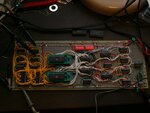eddieAng
Newbie level 4
Hi,
I am on a fact finding mission at the moment, before I start a personal project.
I will like to create a circuit using off-the-shelf chips that I hope to acquire cheaply. I will like to build it on a verroboard, and solder them the old-school way. From my understanding, it is not possible to do that unless the chip in question has a certain type of packaging. What should I look out for to ensure that I can attach the chip to my board?
Thanks in advance
Ed
I am on a fact finding mission at the moment, before I start a personal project.
I will like to create a circuit using off-the-shelf chips that I hope to acquire cheaply. I will like to build it on a verroboard, and solder them the old-school way. From my understanding, it is not possible to do that unless the chip in question has a certain type of packaging. What should I look out for to ensure that I can attach the chip to my board?
Thanks in advance
Ed
